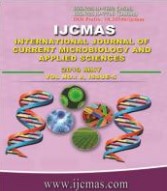


 National Academy of Agricultural Sciences (NAAS)
National Academy of Agricultural Sciences (NAAS)

|
PRINT ISSN : 2319-7692
Online ISSN : 2319-7706 Issues : 12 per year Publisher : Excellent Publishers Email : editorijcmas@gmail.com / submit@ijcmas.com Editor-in-chief: Dr.M.Prakash Index Copernicus ICV 2018: 95.39 NAAS RATING 2020: 5.38 |
Over the period of years infections caused by multidrug resistance organisms has emerged as a major public health problem. Their prevalence rates vary in different parts of the world and hence local data regarding these pathogens were important. Our study was aimed to identify the presence of ESBL and AmpC producing Enterobacteriaceae isolates from various clinical samples in our hospital setup various clinical samples were processed consecutively during the study period for microbiological analysis as per standard operating procedure. Enterobacteriaceae isolates were further tested by phenotypic confirmatory methods for ESBL and AmpC production, as per CLSI guidelines. Out of 1583 samples processed, 522 samples were culture positives (32.97%). 74.52% of isolates belongs to Enterobacteriaceae family. Most common Enterobacteriaceae isolate was E.coli (42.42%) followed by Klebsiella species (41.90%) and Proteus species (11.06%). Among the total 389 Enterobacteriaceae isolates 152(39.07%) were ESBL producers and 8(2.11%) were Amp C producers. E.coli and Klebsiella species were the most common ESBL producing isolates (41.45% each), whereas the majority of AmpC producers were K.pneumoniae (75%). Early detection and proper management of infections caused by these MDR organisms are very important in preventing their emergence and spread. Time to time knowledge about their prevalence and their antibiotic resistance pattern can become a powerful tool in handling infections caused by them.
 |
 |
 |
 |
 |